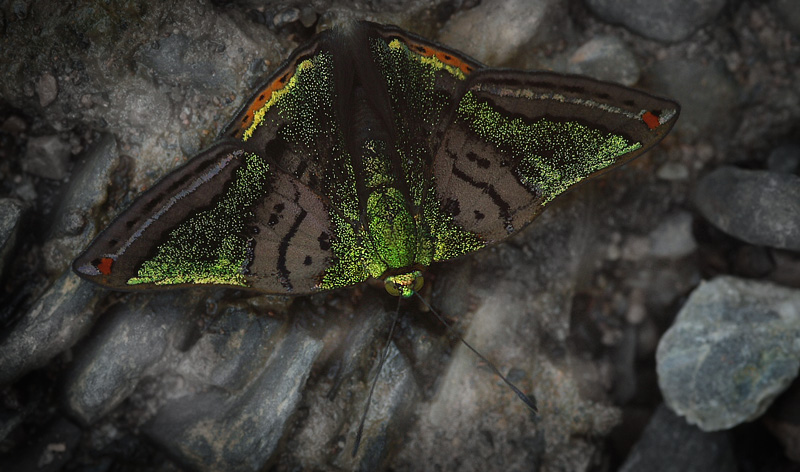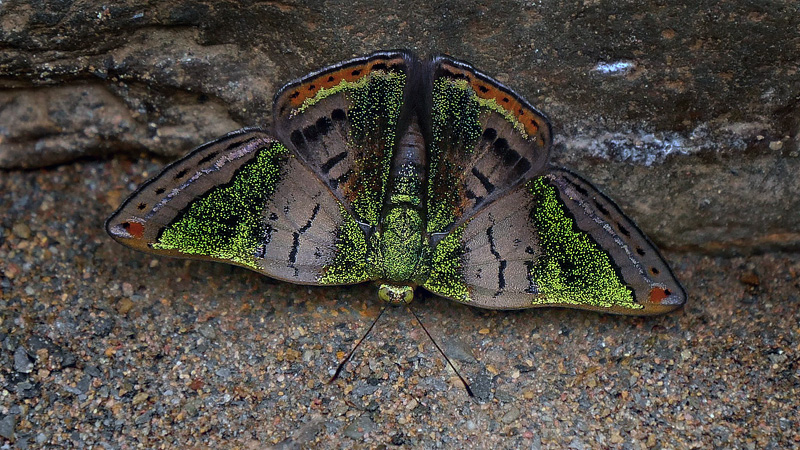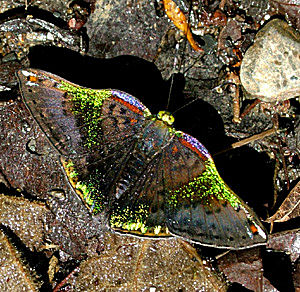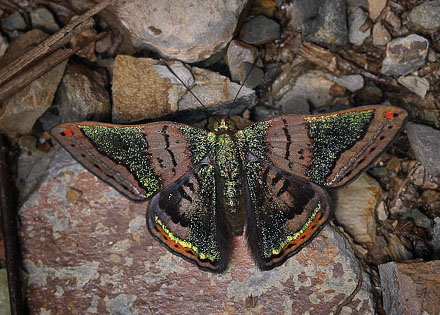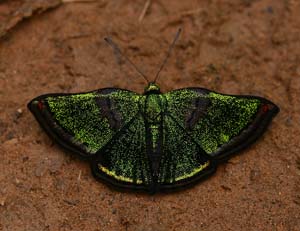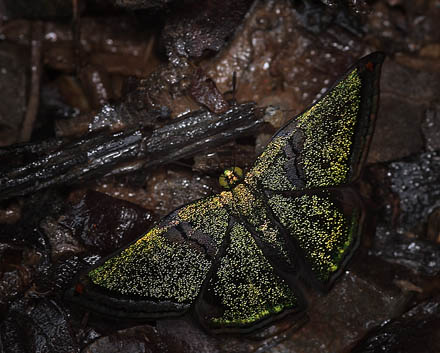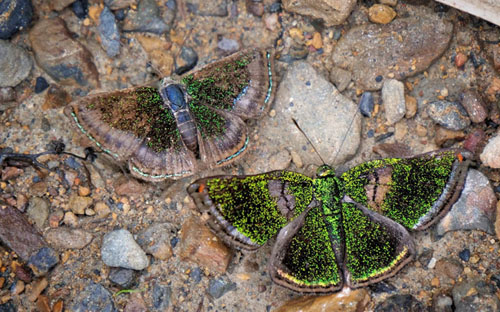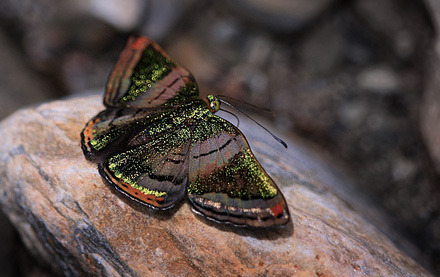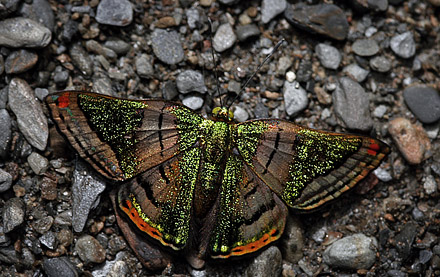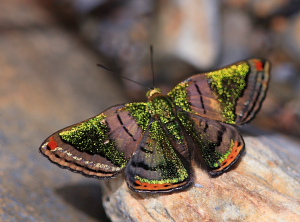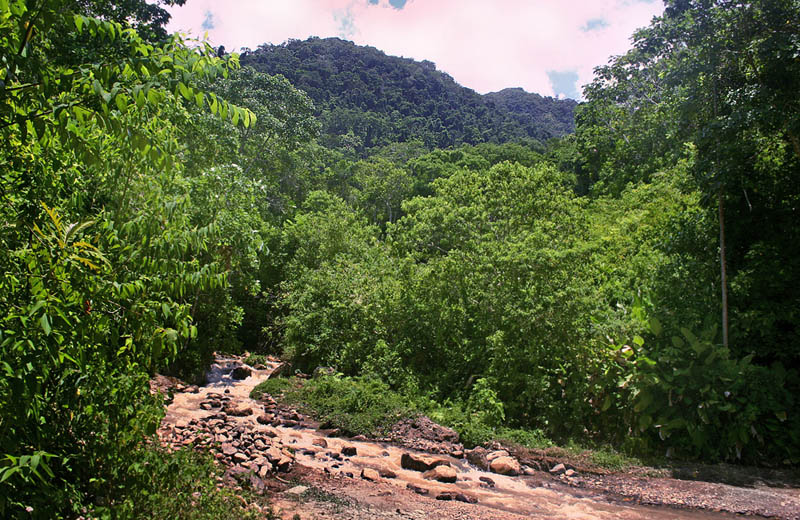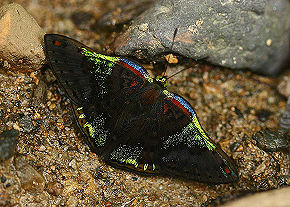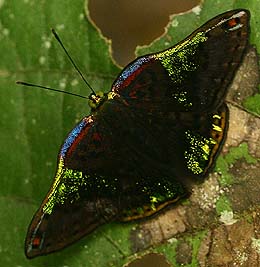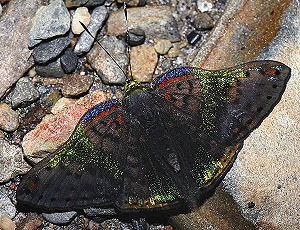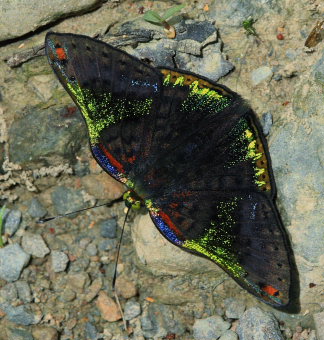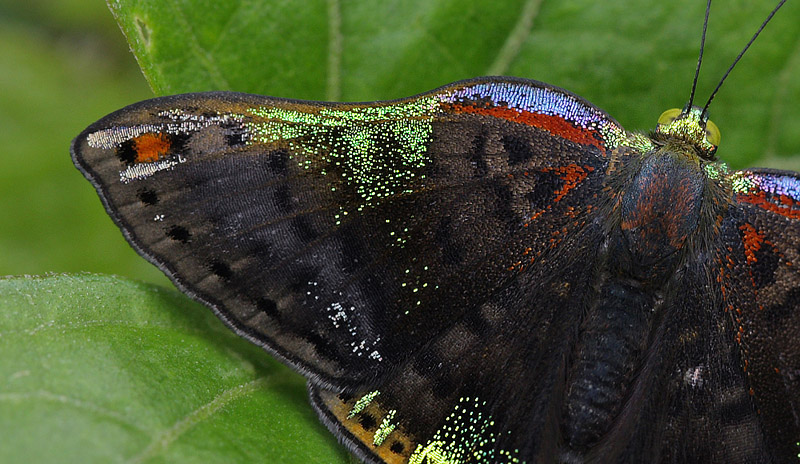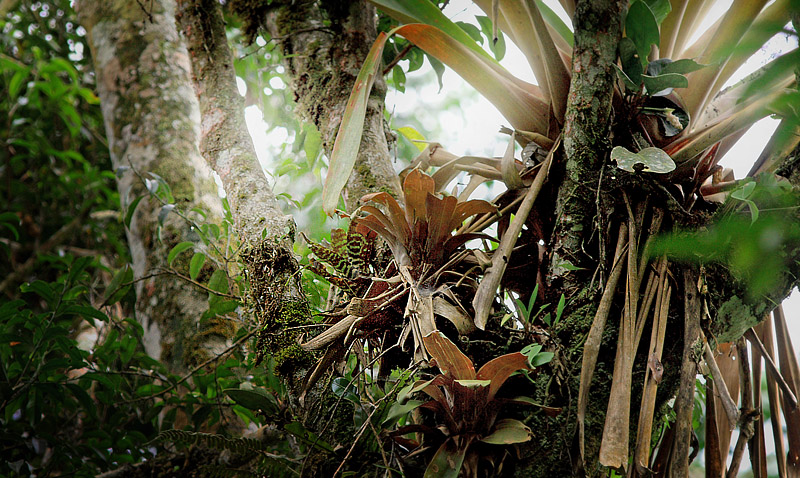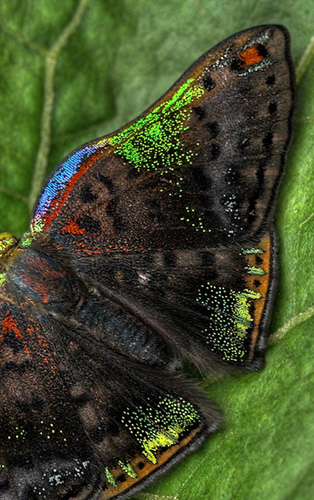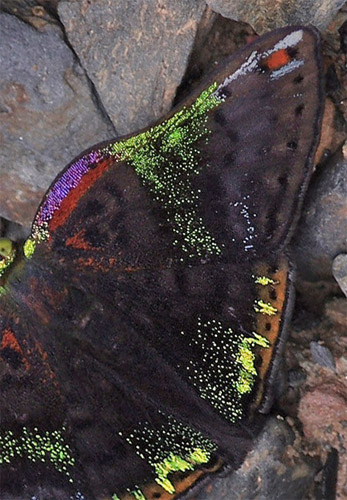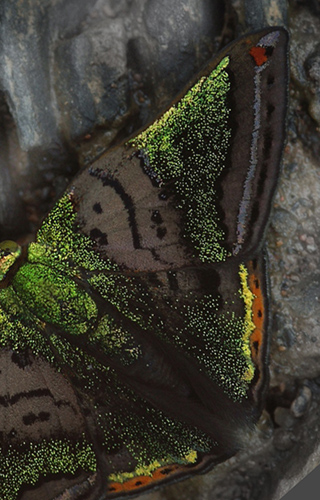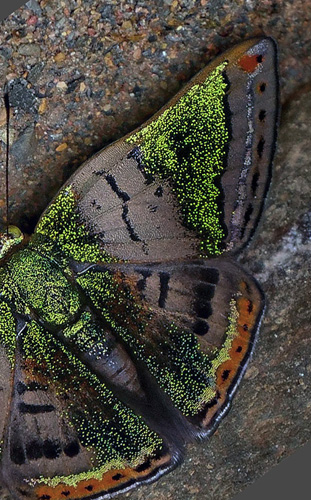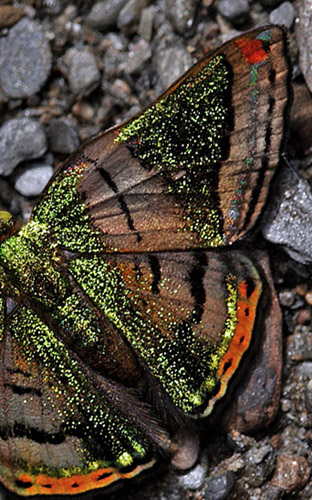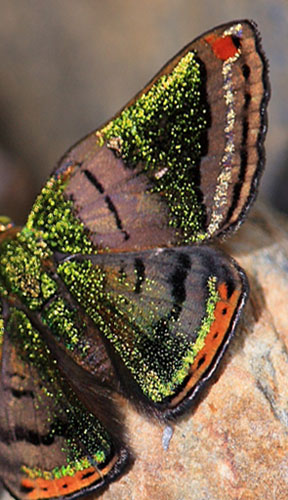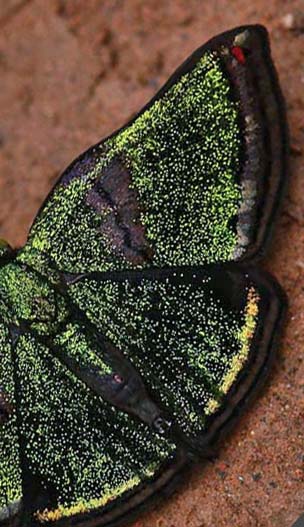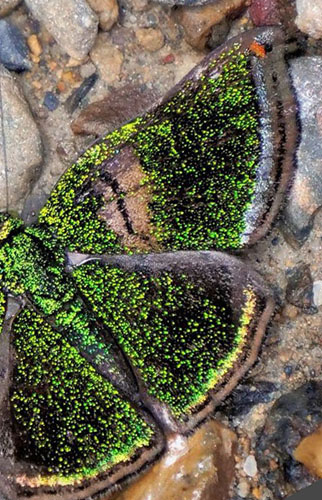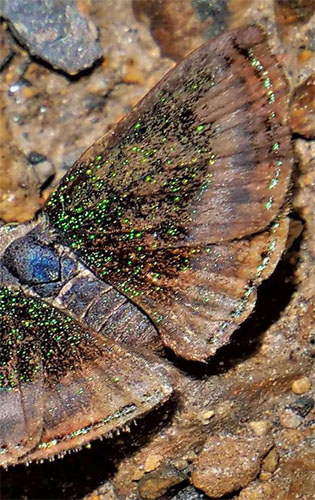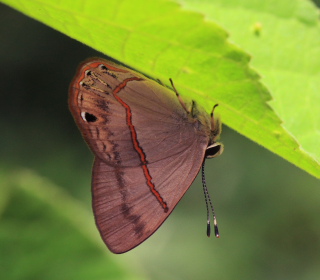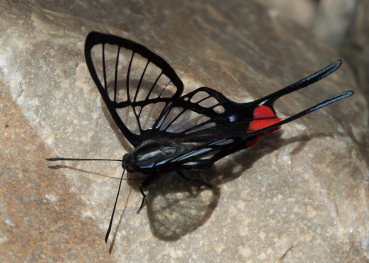Riodinidae
Mariposas de Bolivia
sitio 55
first update d. 23 december 2015
last update d. 3 september 2021
Redactor: Lars Andersen
bajo construccion
_______________________
Emeralds Metalmarks, genus Caria (Hübner, 1823)
Caria unknown species? Caranavi, Yungas, Bolivia d. 19 January 2010. Photographer; Lars Andersen
| The
genus Emerald
Metalmarks, Caria contains
some of the most beautiful and elusive species on
Earth. Although fairly common they are rarely
seen due to their secretive habits, and are
virtually impossible to follow in flight. Once
seen these glittering jewels of the Amazon are
never forgotten. You often feel quite overwhelmed by the beauty of these butterflies, but initial feelings of ecstasy are soon replaced by the rapid onset of frustration, anguish, despair and an uncontrollable urge to spend the next 2 hours hawking relentlessly in the vicinity of the sighting, peering into bushes, crawling about on the ground and searching every nook and cranny, while muttering and pleading with the butterfly to reveal itself !
_______________________ Smaragdgrønne Metalvinger, slægten Caria (Hübner, 1823) Regnbuefarvet Metalvinge, Caria trochilus. Vagantes, Yungas d. 23 Januar 2005. Fotograf; Lars Andersen Slægten Smaragdgrønne Metalvinger, Caria indeholder nogle af de smukkeste og mest flygtige dagsommerfugle arter på jorden. Selvom flere af arterne er forholdsvis lokal almindelige, bliver de sjældent set på grund af deres gådefulde levevis, og det er næsten umuligt at følge denne lille mørke sommerfugl under flugt. Man føler sig ofte helt overvældet af synet af disse små grønne juveler, men de første ophidsede følelser, bliver hurtigt erstattet af frustration, angst, fortvivlelse og en ukontrollabel trang til at tilbringe de næste timer i utrætteligt jagt omkring hvor man sidst så den, kiggende inde i buske, kravle rundt på jorden og afsøge alle kroge og hjørner, mens man mumler og bander, for man håber at denne smukke juvel vil vise sig igen! Når man først har set en af disse skinnende smaragdgrønne juveler fra Andesbjergene tågeskove og Amazonas, glemmer man dem aldrig siden jeg så en den første gang i Vagantes i nærheden af Rio Coroico, Yungas, Bolivia i januar 2005. |
Castalia Green Mantle, Caria castalia (Ménétriés, 1855). Vagantes, Yungas, Bolivia d. 25 januar 2006. Photographer; Lars Andersen
Caria unknown species? Caranavi, Yungas, Bolivia d. 17 february 2007. Photographer; Lars Andersen
| There are 14 species in
the genus Caria, 5 of which are restricted to
Central America, while the others including Caria mantinea and C. sponsa are found primarily in Amazonia
and the foothills of the eastern Andes. Several of the species including C. mantinea, C. plutargus, C. castalia and C. smaragdina are almost identical on the upperside. I have photographed more like where bands runs different from the known species, but requires enough more evidence and DNA analysis to determine them to species? Caria trochilus is much darker than these, with an almost black ground colour. It could possibly be confused with rhacotis as both have metallic blue scales at the base of the costa. Caria rhacotis however, in addition to having a paler ground colour, has more extensive red scaling at the base of the forewings, and has a thin silver submarginal line on fore and hind wings. _______________________
Caria chrysame (Hewitson 1874) and Brillantina, Caria plutargus (Fabricius, 1793). Copacabana, Caranavi, Yungas, Bolivia december 26, 2018. Photographer; Peter Møllmann I slægten Caria findes der ca. 14 arter , hvoraf 5 er begrænset til Mellemamerika, mens de andre, herunder Caria mantinea og C. sponsa findes primært i Amazonas og langs de østlige Andesbjerge i skoven fra 200 til 1000 m.h. langs raviner med mindre vandløb. Adskillige af arter, herunder Caria mantinea, C. plutargus, C. castalia og C. smaragdina er næsten identiske på oversiden, smaraggrønne med grå bånd. Jeg har fotograferet lignende 2 ukendte arter, hvor bånd forløber anderledes end de kendte arter, men der kræves nok mere dokumentation og dna analyser for at bestemme dem til art? Caria trochilus er meget mørkere end de andre arter, med en næsten sort grundfarve. Den kunne muligvis forveksles med C. rhacotis som begge har metallisk blå skæl i rodfelt på forvinge forkant. C. rhacotis har imidlertid ud over at have en lysere grundfarve, en mere omfattende rød stribe i rodfelt på forvinge, og har en tynd sølvfarvet linje i sømfelt på for- og bagvinge. |
| Green Mantle, Caria mantinea lampeto (Godman & Salvin, 1886). |
| Challa, Yungas, Bolivia d. 25 February 2008. Photographer; Lars Andersen |
Green Mantle, Caria mantinea
lampeto (Godman
& Salvin, 1886).
Highlands
near Caranavi, Yungas, Bolivia december 11, 2018. Photographer; Peter Møllmann
Sponsa Metalmark, Caria sponsa (Staudinger, 1887).
Piedras
Blancas y Agua de la Vida, Bolivia 22.-27. Julio
2021.
Photographer; Gottfried Siebel
22.-27. Julio 2021 Piedras Blancas y Agua de la Vida
Con Martin Apaza Ticona
_______________________
Rainbow Metalmark, Caria trochilus. Coroico 1300 m.h. d. 9 february 2012. Photographer; Lars Andersen
| Rainbow
Metalmark, Caria trochilus (Erichson, 1849) and Caria trochilus arete (C. Felder &
R. Felder, 1861) Description: wings are black gray on the side
with shiny emerald green bands, along forewing
edge in the root area has a blue and red stripe.
Wingspan: 26-30 mm. Habitats: Adult behaviour: They have a rapid and erratic flight which is virtually impossible to follow with the eye. However with practice it is often possible to relocate them once they resettle, as they tend to only cover quite short distances. Usually they settle on the ground, but sometimes they land on foliage, or on a damp sunlit rock or boulder. The butterflies usually bask with the forewings swept back, half covering the hindwings. |
Caranavi, Yungas, Bolivia d. 6 february 2007. Photographer; Lars Andersen
_______________________
| Rainbow Metalmark, Caria trochilus. | ||
|
||
| Photographer; Lars Andersen | ||
Regnbuefarvet Metalvinge, Caria trochilus (Erichson, 1849) & Caria trochilus arete (C. Felder & R. Felder, 1861) Udseende: vingerne er sortgrå på overside med skinnende smaraggrønne bånd, langs forvinge kant i rod felt har den et blåt og rødt stribe. Vingefang: 26 - 30 mm. Habitat: Voksen adfærd: De har en hurtig og uregelmæssig flyvning, som er næsten umuligt at følge med øjet. Men med øvelse er det muligt at følge dem, når de lander igen, da de har tendens til kun at flyve ganske korte afstande. Normalt lander de igen på sandet, men nogle gange de lander på blade eller på en fugtig solbeskinnet klippe eller kampesten. Sommerfuglen hviler normalt med fladt udbredte vinger, hvor forvinge er fejet tilbage, halvt dækkende over bagvinge. |
| Rainbow Metalmark, Caria trochilus arete (C. Felder & R. Felder, 1861) | |||
|
|||
| Photographer; Lars Andersen | |||
| Lifecycle: There is no information on Caria trochilus, but the lifecycle is likely to be very similar to that of other Caria species as follows: The eggs are laid singly under the leaves of Ulmaceae, Iguana Hackberry, Celtis iguanaea or Bromeliaceae. The caterpillars are densely hairy, and live and feed within rolled leaf tubes. Distribution: _______________________ Levevis: Udbredelse: |
Rainbow Metalmark, Caria trochilus. Coroico 1300 m.h. d. 9 february 2012. Photographer; Lars Andersen
_______________________
Rainbow Metalmark, Caria trocchilus
d. 9 april 2017
Regnbuefarvet Metalmarkvinge, Caria trochilus fra Caranavi Bolivia, januar 2017, filmet med GH4 af Peter Møllmann.
_______________________
Bromeliaceae species. Caranavi, Yungas, Bolivia d. 14 february 2008. Photographer; Lars Andersen
_______________________
Link til indlæg om Caria på "kryb & kravl" på facebook d. 25 dec. 2015.
_______________________
_______________________
Nine Caria species found in Bolivia as well as unknown species. 2018
| species | subspecies | Autor | South America | Bolivia |
| Caria rhacotis | (Godman & Salvin, 1878). | S Mexico to Peru | Rurrenabaque, Paradaiso Guerra & Siebel |
|
| Caria trochilus | (Erichson, [1849). | Guayana | Chulumani Weeks | |
| Caria trochilus | ssp. arete | (C. Felder & R. Felder, 1861). | Peru] | Coroico, Vagantes Garwood 2013 |
| Caria castalia | (Ménétriés, 1855). | Brazil | Chulumani Garwood 2013 |
|
| Caria marsyas | (Godman, 1903). | Brazil; Paraguay | Tariquia, Salinas, Chiquiaca, La Planchada, El Cajón, Jardín Botánico Gareca & Reichle 2009 |
|
| Caria tabrenthia | (Schaus, 1902). | Peru | Madidi, PN-ANMI Lamas 2004a |
|
| Caria mantinea | (C. Felder & R. Felder, 1861). | (Peru) | Rurrenabaque, Bellavista, Santa Cruz, Jardín Botánico Lamas 2004a |
|
| Caria mantinea | ssp. lampeto | (Godman & Salvin, 1886). | Mexico to Bolivia | Coroico, Puente Elena, Chiquitania, San Sebastián Guerra & Siebel |
| Caria plutargus | (Fabricius, 1793). | "Indiis" | Caranavi, Amboro BBC |
|
| Caria plutargus | ssp. amazonica | (H. Bates, 1868). | Brazil (Am) | Rio Songo, Chiquitania, San Sebastián Fassl 1926 |
| Caria chrysame | (Hewitson, 1874). | Bolivia Lamas 2004a |
||
| Caria sponsa | (Staudinger, [1887]). | Peru | Madidi, Rio Hondo Guerra 2016 |
|
| Caria sp. | Ecuador | Colección MHNNKM 2005 |
_______________________
Euselasiinae & Riodininae
sitio 55
_______________________
Swordtails - Riodinini
sitio 57
_______________________
METALMARKS part3 from Peter Møllmann on Vimeo.
_______________________
Caranavi, Yungas, Bolivia d. 24 february 2007. Photographer; Lars Andersen
_______________________
dont use this pictures without permission from:
photographer © Lars Andersen
_______________________
Mariposas de Bolivia
Enero 2009
por Peter Møllmann y Lars Andersen
_______________________
link to Neotropical Butterflies of Will Carter and Kim Garwood, Metalmarks
Esmeralda hotel, Coroico, Yungas
_______________________
